[GTranslate]
When the VFR1200F was introduced to us last fall in Japan, Honda engineers described a hypothetical middle-aged rider who wanted a sportbike to ride on twisty roads but who has to travel 75 to 100 miles to get to them.
Full-on 1000cc sportbikes are too uncompromised for long-distance trips, becoming uncomfortable for aging wrists, and have maintenance-heavy chain drives. But the 1300cc class of sport-tourers scale in at or above a porky 650 lbs, compromising their agility in sport-riding situations.
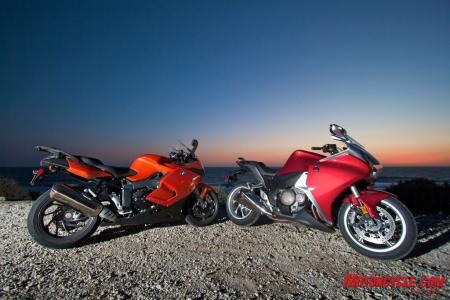 The sportbikes of sport-tourers: BMW K1300S vs Honda VFR1200F. The sportbikes of sport-tourers: BMW K1300S vs Honda VFR1200F. |
Kawasaki and Yamaha have described their S-Ts as “supersport tourers.” If that’s the case, then the VFR and K1300S are super-duper supersport tourers!
The Perfect Match
The K13 and VFR stand apart in their tween-ness. Both boast four-cylinder motors with similar displacements – there is a discrepancy of only 56cc between the 1237cc Honda and 1293cc Beemer, with both posting nearly identical peak power numbers. Single-sided swingarms with shaft drive makes the pair distinct from the chain-drive Kawi ZX-14 and Suzuki Hayabusa, as does their ability to mount accessory saddlebags. Base prices are just $449 apart. Honda’s dual-clutch version of the VFR has yet to become available.
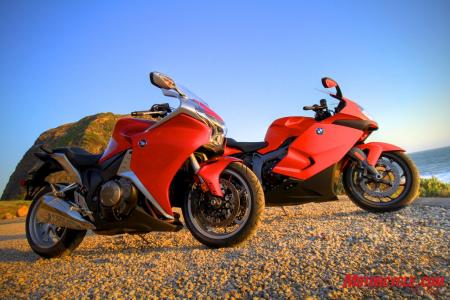 ‘Tweens: Neither pure sportbike nor fully equipped sport-tourer. ‘Tweens: Neither pure sportbike nor fully equipped sport-tourer. |
The VFR’s $15,999 MSRP is, somewhat surprisingly, above the K13’s. But judged by finish detail and build quality, the Honda clearly looks more expensive. Honda has a new paint process in which the parts are gently agitated to yield a glass-smooth surface, and the VFR is one of the first bikes to receive this high-end treatment.
| Take That, Harley! | |||||||||||||||
A smooth paint finish is desirable on any vehicle, and it’s especially critical on a motorcycle’s fuel tank because its proximity to the rider is, literally, under his nose. Honda’s new process in which painted components are sprayed while being gently shaken yields an amazingly smooth surface. Below are some stats claimed by Honda. For reference, a value of 0 (zero) is as smooth as glass.
We were given a first-hand look at this technology when we visited Honda’s Kumamoto factory in Japan last fall. We were presented with three fuel tanks – from an older Honda cruiser, a Harley and a new Honda cruiser – which we inspected under magnification. Indeed, the new Honda’s tank was visibly glassier than the Harley’s. Very impressive. |
|||||||||||||||
The Viffer Grande’s flawless paint and smooth bodywork joints are just a couple of reasons this Honda could be pinned with the upmarket Acura badge. The downside to the clean body panels are hidden fasteners that complicate the disassembly/reassembly process – an ordeal that’ll make a reasonably bright 40-year-old as frustrated as an 8-year-old trying to assemble IKEA furniture.
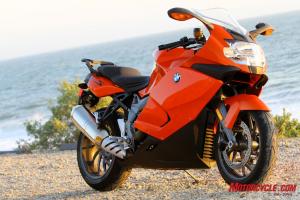 The BMW 1300S exhibits chunkier styling than the curvy VFR.
The BMW 1300S exhibits chunkier styling than the curvy VFR.As is typical of BMW, the K1300S is nicely finished, with attractive surface detailing and quality materials, but it doesn’t have the sheen and gleam of the VFR which sets new standards for sporting motorcycles. Examples are the VFR’s stylish mirrors with integral turnsignals that look much more expensive than the flat-black nylon mirrors on the K bike.
The design language in terms of style couldn’t be more divergent. The Honda is penned with soft curves that blend like a well-used bar of soap, contrasting sharply with the BMW’s hard edges and angles. Detractors will say the K looks a bit too Transformers-ish and the 1200F looks too bland. Opinions vary wildly, but we can report that in-the-flesh judgments of the Honda were consistently more favorable than when evaluating only from 2-dimensional pictures.
Climbing aboard, the Honda’s well-finished cockpit exudes quality. Switchgear feels expensive to the touch. The gauge panel is nestled smoothly below the windscreen, proudly displaying an analog tach in the center flanked by two LCD displays. Its digital speedo is easier to read than the crowded digits on the K13’s traditional analog speedometer. The K’s circular main dials are augmented by an LCD panel that displays a host of info including gear position like the VFR.
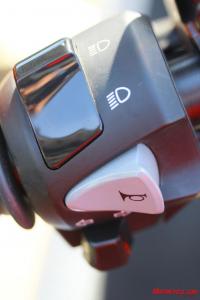 We aren’t fans of the VFR’s relocated horn button where we expect a turnsignal switch to be.
We aren’t fans of the VFR’s relocated horn button where we expect a turnsignal switch to be.In an ironic twist, it’s the Honda that has an odd placement of its turnsignal switch. It’s located where the horn button is usually found, ostensibly for speedier activation of the horn. It also causes people to look at you when they hear you beeping for no apparent reason until finding the button becomes second nature.
“In an ironic twist, it’s the Honda that has an odd placement of its turnsignal switch.”
The K13 family was one of the first BMWs to change to the single left-thumb button we’re all familiar with instead of the former three-button BMW arrangement. The K13 gets bonus marks for its self-canceling turnsignals, something the VFR lacks – an inconvenient omission for such a premium machine.
“The BMW’s updated-for-‘09 switchgear is good stuff,” Pete notes. “The integrated start button/kill switch, as well as integrated passing light/high beam, just make sense. I also like that the indicator switch only needs a limited amount of range before activating the turnsignals.”
Launch Time
The K13’s inline-Four fires easily and emits a raspy exhaust note, sounding racier and quicker to rev than the V-Four Honda. Only a whiff of the K13’s throttle is needed to take off from a stop, and this is a boon because its clutch engages at the end of its travel and is grabby during higher-rpm launches. On a related note, its large clutch pack interferes with a rider’s right leg at stops.
“The big engine in the K bike feels quite sporty, like it’s accelerating with ferocity,” Pete enthuses, “to the point that going on just engine sound and feel as indications of when to shift had me shifting a few thousand rpm below actual redline.”
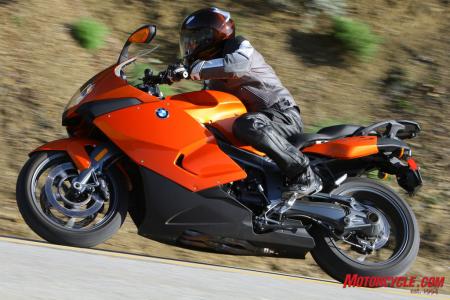 BMW’s K1300S has a potent powerplant. BMW’s K1300S has a potent powerplant. |
Throttle response is much improved from the previous K1200 but still suffers a digital feeling. Reaction from the motor isn’t always perfectly congruous with what’s being asked for from the ride-by-wire throttle. We noticed a subtle lag when getting hard on the gas that felt akin to a carbureted bike running rich, as if BMW was trying to ensure the K13 doesn’t have any throttle abruptness. We also weren’t keen on the excessive amount of compression braking when rolling off the throttle at high revs.
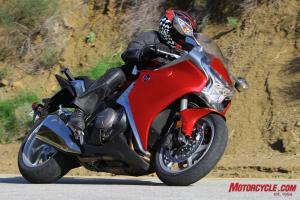 The Honda’s V-Four engine is unlike anything else on the market.
The Honda’s V-Four engine is unlike anything else on the market.The K1300 has a narrow midsection thanks to the inline-Four’s lay-down cylinders and its aluminum frame designed to be slim below the rider. The VFR enjoys the inherent narrowness advantage of its V-Four mill, enhanced even further by Honda cleverly having the rear cylinders’ rod journals rotating inboard of the front cylinders’ rods, enabling the rear cylinders to be skinnier than the fronts. It’s remarkable how compact the VFR feels for a 1237cc motorcycle.
The front and rear cylinders of the VFR are set 76 degrees apart, and its crankpins are offset 28 degrees to eliminate primary vibration. The resulting exhaust note is unlike any previous VFR and less inspiring than I’d hoped from a semi-exotic V-Four. It sounds oddly like a BMW Boxer motor until its exhaust valve opens at 6000 rpm, then becomes raspy like some kind of hybrid two-stroke. We’d be curious to hear it breathe through a freer-flowing muffler.
Quick roll-outs are enabled by the VFR’s wide powerband and a cooperative clutch take-up zone. The V-Four pulls cleanly from as little as 1500 rpm, and it’s very smooth up top. Such is its smoothness that, on one sporting canyon ride, I hit the 10,600-rpm rev limiter in second gear while being blissfully unaware I was so high up in the rev range.
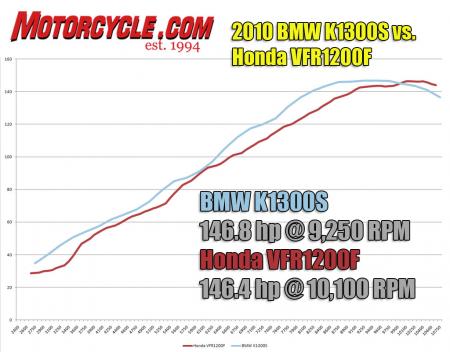 Rev to rev, the Beemer’s four cylinders punch out more power than the Honda’s throughout the usable powerband. It’s only around 10,000 rpm when the VFR has a slight advantage as the K tapers off. Rev to rev, the Beemer’s four cylinders punch out more power than the Honda’s throughout the usable powerband. It’s only around 10,000 rpm when the VFR has a slight advantage as the K tapers off. |
In terms of power, both bikes yank out 146 horsepower at the rear tire, which is impressive in itself. But the key to these big-cube motors spinning speedo numbers ridiculously quickly is the early production of torque. Each has more than 70 ft-lbs of twist available as early as 4000 rpm, providing the grunt necessary to attain Big Speed from nearly any point on the tach.
The Honda has a very linear powerband once a low-rpm dip is passed around 3500 rpm, with a flat torque curve that peaks with 82.0 ft-lbs at 8700 rpm. Despite a V-Four’s reputation for superior low-end urge, the K13’s well of power runs deeper. It cranks out more than 80 ft-lbs over a 4000-rev span beginning at 5500 rpm, culminating with almost 90 ft-lbs at its 8000-rpm max output.
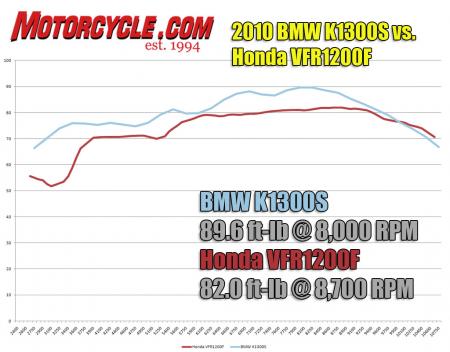 The Beemer’s slightly bigger motor puts up a dyno chart even more impressive than the VFR’s. A low-rpm dip in the Honda’s chart results in a 20-plus ft-lb advantage for the K1300S at 3500 rpm. The Beemer’s slightly bigger motor puts up a dyno chart even more impressive than the VFR’s. A low-rpm dip in the Honda’s chart results in a 20-plus ft-lb advantage for the K1300S at 3500 rpm. |
As for the VFR1200F, Honda’s first electronic throttle system has its own peccadilloes. Ridden at a moderate pace, it’s practically flawless. But when flogged, we noticed soggy throttle response below 5500 rpm. In the lower gears, it feels like it pulls from three-quarter throttle as strong as it does from just one-eighth throttle, as if the ride-by-wire system isn’t giving exactly what a rider is asking for. A minor occasional-but-not-consistent abruptness when reapplying the throttle can make for agitated nerves.
This pair of 6-speed gearboxes also falls into the excellent-but-flawed category. The VFR really impressed us with the silkiness of its transmission. “I was awestruck in the first few miles with the near-perfect gearbox,” Pete enthuses, “Shifting is so transparent that if it weren’t for the gear position indicator in the LCD I couldn’t have been certain that I actually changed gears.”
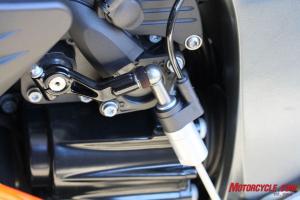 BMW’s Gear Shift Assistant allows upshifts without backing off the throttle or pulling the clutch lever.
BMW’s Gear Shift Assistant allows upshifts without backing off the throttle or pulling the clutch lever.The only negative comment about the VFR’s tranny is that hurried, high-rev upshifts from first gear didn’t always make it to second gear. “You need to be deliberate or you will be revving in neutral,” notes guest rider Glenn Giardinelli. And although the Honda is equipped with a slipper clutch to ease downshifts, it isn’t as slippery as the CBR1000RR’s or other literbikes.
The K1300’s gearbox is quite good, aided on our test bike by the optional Gear Shift Assistant that allows upshifts without using the clutch or backing off the throttle. But Pete noted notchy downshifting and says it lacks the refined quality found in the Honda’s gearbox.
The shaft-drive systems on both bikes suffer more driveline lash than a chain- or belt-driven bike, although it’s only really noticed when the bikes are being caned on a twisty road. Otherwise, these are exceptional shafties, with only a hint of jacking the rear suspension. The VFR’s engine uses stacked transmission shafts to keep the powerplant as short as possible, and this enables deployment of a long swingarm to reduce shaft-drive jacking within an acceptably short 60.8-inch wheelbase.
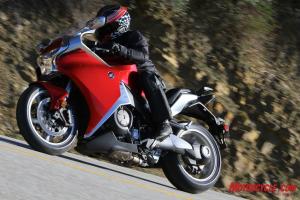 The responsive VFR1200F feels much lighter than it is.
The responsive VFR1200F feels much lighter than it is.One thing Honda really nailed with the VFR is its neutral and natural demeanor, giving a rider confidence to take control of any situation after only a few revolutions of its wheels.
“Though Honda says the bike weighs 591 pounds ready to ride, initial steering effort and overall handling qualities belie the nearly 600 pounds,” Pete explains. “The VFR is responsive to the slightest steering or body language input, yet it’s not skittish. And it’s as stable mid-corner as the rock-steady K13S.”
The K1300S’s wheelbase stretches about 1.5 inches beyond the VFR’s, but the bike feels even longer than that. Partially to blame is the K’s oddball Duolever fork which is positioned at a lazy 29.6-degree rake angle. Contrast that with the sportier 25.3 degrees of the Honda’s inverted telescopic fork. Trail numbers are nearly identical, with the K’s 3mm greater than the VFR’s 101mm.
On the road, the VFR feels wieldier in most circumstances, particularly during low-speed maneuvers and on tight canyon roads. It’s the more agile machine despite carrying about 30 extra pounds – it feels like a much lighter bike than it appears on a spec chart. Front-end feel isn’t quite on par with a pure sportbike, but feedback is delivered clearer than with the BMW’s Duolever unit.
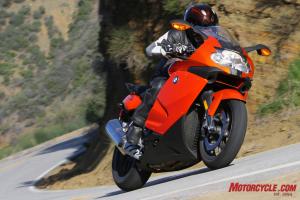 The K1300S has outstanding stability in high-speed turns.
The K1300S has outstanding stability in high-speed turns.“It takes on canyon roads with what I’d estimate to be 85% of the ability of a Gixxer 1000,” says Giardinelli, owner of a GSX-R1000.
The K13’s forte is in fast, sweeping curves where its lanky chassis geometry provides for exceptional stability. And when we say it corners as if on rails, we mean it doesn’t really want to deviate from its course when at higher speeds. A twisty mountain road will tire the Beemer rider quicker than a Honda pilot, but the K13 is nevertheless spritely enough to scythe canyons with supersport-mounted buddies. Ground clearance on both bikes is quite good, but the Honda has a slight edge with its higher footpegs.
Ergonomics are an important consideration for a long-distance ally, and both bikes are set up to be comfortable but sporty. The Viffer’s riding position is very neutral, with just a slight lean forward to the high-mounted clip-on handlebars. A K13 rider has a bit more of a stretch to the bars, which fit tall riders fine but places pressure on the wrists of shorter riders like Pete: “I prefer the Honda’s more upright clip-ons to the BMW’s lower bar. Riding the Beemer, my hands and wrists would protest after a while, but not so on the VFR.”
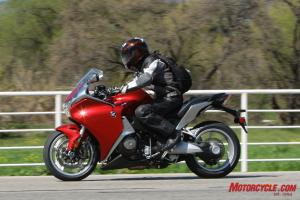 The VFR’s bars are slightly higher than the K1300’s, but it has a slightly shorter seat-to-peg distance.
The VFR’s bars are slightly higher than the K1300’s, but it has a slightly shorter seat-to-peg distance.Seat design is always going to be a compromise, especially on a sporty bike like these. A wide, thick seat offers more comfort but is awkward at low speeds and when sport riding. The VFR’s 32.1-inch seat is claimed to be just 0.2 inch lower than the K1300’s, but it’s so narrow at the fuel tank junction that it feels even lower than that. The 5-foot-6-inch Giardinelli appreciated the easy reach to the ground, but he whined that the seat is too narrow for good support when he sits close to the tank while sport riding. Longer-armed riders are able to sit back on the seat’s supportive wider section and were pleased with the comfort.
The BMW’s thicker seat padding and slightly lower footpegs supply about an inch more legroom than the Honda, making it a better fit for those with gangly legs. Short riders might want to order the accessory low seat (31.1 Inches) that is a no-charge option when buying new.
Considering their svelte fairings and moderately low windscreens, both bikes do a surprisingly good job at protecting riders from the elements without using wide bodywork or barn-door windshields. Our shorter test riders were happy with the available shelter, but taller riders receive moderate helmet-level windblast. The VFR has an optional windscreen extension accessory that should provide a bigger bubble of unstirred air. The Honda’s layered body panels perform well at routing hot air away from its rider.
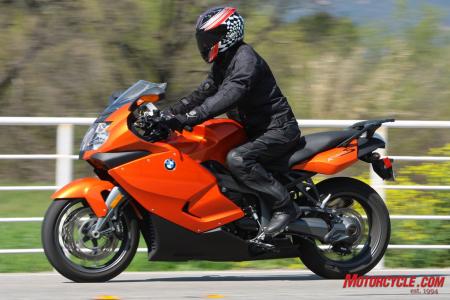 BMW’s K1300S has a comfortably sporty riding position. BMW’s K1300S has a comfortably sporty riding position. |
| Where’s the Bags? |
Both BMW and Honda are angling this duo toward the sport side of the sport-touring equation, so price and weight are kept to a minimum by excluding several typical touring amenities. But long-haul riders haven’t been forgotten, as there is a plethora of touring-oriented accessories to tick off in the options box.
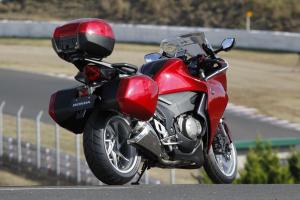 Got stuff? The VFR1200F’s optional luggage provides places to put it. Note also the optional windscreen extension. Got stuff? The VFR1200F’s optional luggage provides places to put it. Note also the optional windscreen extension.BMW is perhaps the leader in providing optional accessories for its bikes, and our K1300S supports that theory. To its $15,500 base MSRP, our test unit was fitted with the $2,250 Premium Package that includes heated grips, electronic suspension adjustment, traction control, tire-pressure monitoring and the Gear Shift Assistant. Also fitted to our bike was a small luggage rack ($150). BMW’s Sport Case saddlebags and related bracketry retail for $1,000.85 The list of options from Honda isn’t as extensive as its German rival’s, but stylish and color-matched hard-shell saddlebags ($1,399.95) will be at the top of a touring rider’s option list. The VFR’s tailsection is equipped with integrated bag mounts that are almost invisible. Also available is a color-matched trunk ($599.95). We’re happy to report the VFR can be ordered with a trick set of heated hand grips ($349.95) that supply more heat to the front of the grips where it is most needed. Also available is a centerstand ($249.95) a windscreen extension ($249.95) and a 12-volt power port ($99.95). |
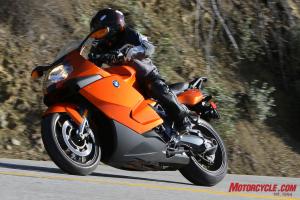 The immediate remote adjustability of BMW’s ESA II suspension is ideal for a multi-role fighter like the K1300S.
The immediate remote adjustability of BMW’s ESA II suspension is ideal for a multi-role fighter like the K1300S.In the suspension category, the Beemer steps up with its second generation of electronic suspension adjustment, ESA II, in which it automatically changes the shock’s spring rate based on the combination of damping and preload setting chosen from the system’s three modes. ESA II is part of the $17,800 Premium Package fitted to our test bike, and it can also be ordered as an a la carte option for $900.
ESA II proves to be ideal for a bike in this category of motorcycles, enabling markedly different suspension performance at a touch of a button. When it’s time to drone on the superslab on the way to the squiggly lines on a map, simply dial up the Comfort setting for a spine-easing cushy ride. And when it’s time to chase down a Gixxer up a canyon road, a firm and buttoned-down ride is available at a push of a handlebar-mounted button to switch to Sport mode.
Honda took a simpler suspension route, choosing to minimize adjustments to just spring preload and rear rebound damping. Rear preload is hydraulically adjustable by a dial near the left passenger footpeg. The minimally adjustable suspension turns out to be an excellent compromise between comfort and sport, supplying a delicate balance of suppleness and control despite its relative simplicity.
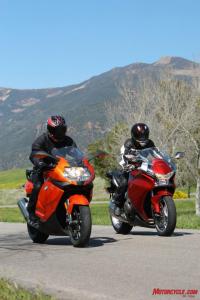 Both bikes have terrific ABS brakes and smallish fuel tanks.
Both bikes have terrific ABS brakes and smallish fuel tanks.Braking performance is another area of excellence, with the triple-disc sets providing outstanding power and standard anti-lock control. Graybeards may fear ABS, but they shouldn’t, as these modern systems are minimally invasive. Nor should they gripe about Honda’s linked brake system in which the brake pedal activates two pistons in the left front 6-piston caliper; it’s not linked front to rear.
“The brakes are some of the best I’ve ridden to date,” raves Pete who has ridden nearly every brake system out there. “The amount of force available at the lever is on par with many Brembo systems I’ve ridden; and feel is equally as excellent.”
One of the downsides to a sport-touring bike angled toward the sport side is the seeming inevitability of limited fuel capacity. At 5.0 and 4.9 gallons, respectively, the K13S and VFR hold less go-juice than many high-mileage riders would like. If you ride hard like we do, don’t expect much more than a 170-mile range at the 34 mpg we averaged with the VFR. The Beemer averaged a couple mpg better. It would take a restrained wrist to squeeze out 200 miles between fills with either bike.
Regarding passenger accommodations, we weren’t able to find anyone crazy enough to ride with us. But Pete surmised “the K bike might make the better two-up tourer over long distance in light of what seems like a roomier saddle, longer wheelbase and array of suspension adjustment.”
Boiling It Down
Having already sampled the VFR a few months ago, we knew the K1300S was going have a real battle on its hands when we’d get the chance to ride them side by side. As good as the bold new Honda is, we were impressed by how well the K1300S matched up to it. This is an excellent sporting motorcycle with an enviable engine and an interesting set of options.
“Although the BMW may not have the utter refinement of the Honda, I wouldn’t be ashamed or regretful of having a K1300S in my garage if I’d purchased one and then later had the chance to ride a VFR1200F,” says Pete. “Furthermore, the practical techy options like anti-spin control, ESA II, etc, that have real-world application raise the K13’s’s price by only $1,800 more than the Honda’s, making a case for the BMW being the better value. Frankly, the BMW’s Premium Package option is simply worth the added cost over base MSRP, especially so if you amortize that $1,800 across the term of a loan.”
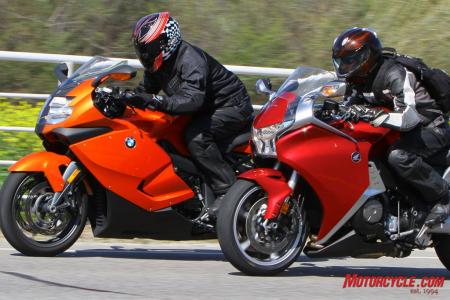 The BMW surges ahead in terms of its wealth of available equipment. The BMW surges ahead in terms of its wealth of available equipment. |
The VFR1200F presents a dichotomy, maybe two. It’s a sport-touring GT, but it doesn’t have a large fuel tank or cruise control. And yet it’s not quite a sportbike, what with its 150 extra pounds over a CBR1000RR and its sport-compromised shaft-drive system.
Old-time VFR fans complain this new Viffer is too heavy to deserve the nomenclature, remembering the landmark V-Four bikes from the 1980s but forgetting the previous VFR has an engine 455cc smaller and weighed just 50 pounds less without shaft drive.
While we’re all trying to stuff the VFR in preconceived boxes, Honda has delivered an exotic and meticulously finished grand-touring machine that can run with nearly anything on the road while coddling its rider in comfort, precisely the target Honda intended to hit.
Honda haters have derided the VFR as being too heavy and not attractive enough for serious consideration, but those people likely haven’t ridden it. Running the 1200F through a tank of gas is a sure way to win over the skeptics. Consider us converted.
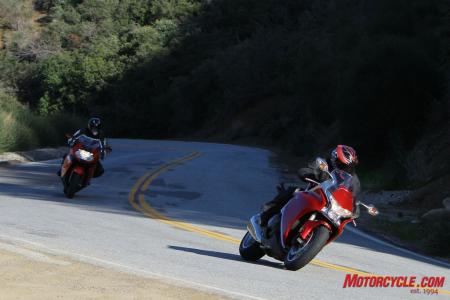 With the emergence of the VFR1200F, the sportbike/S-T hybrid class has a new pecking order. With the emergence of the VFR1200F, the sportbike/S-T hybrid class has a new pecking order. |
Related Reading
2010 Honda VFR1200F Review – First Ride
2009 BMW K1300S Review
2010 Kawasaki Concours 14 Review
2009 Sport-Touring Shootout
2008 Middleweight Sport-Touring Shootout: BMW F800ST vs. Honda VFR800 Interceptor
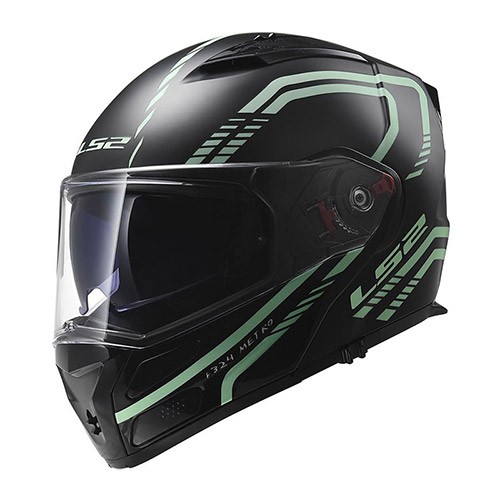

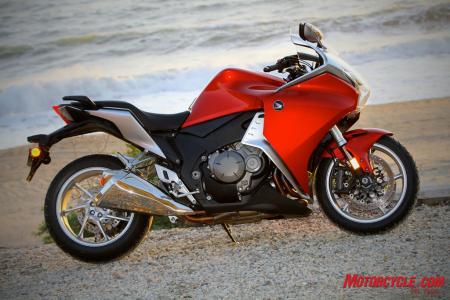 The VFR’s attention to detail and finish quality is superb.
The VFR’s attention to detail and finish quality is superb.